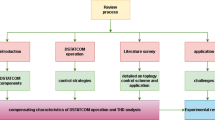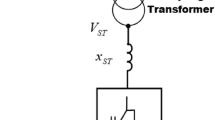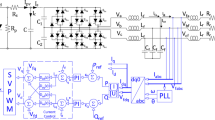Abstract
The main objectives of this paper are to simultaneously improve power system damping and to maintain voltage at the static var compensator (SVC) location bus simultaneously. A new controller for SVC with closed-form analytic solution nonlinear optimal predictive control (NOPC) law was presented. The controller does not require online optimization and the huge calculation burden can be avoided, so that the demand of real-time control can be satisfied. In addition, there are only two design parameters, which are the predictive period and control order, so it is easy to implement and test in practical use. Simulation results have shown that the controller can not only attenuate power system oscillation effectively but can also maintain voltage at the SVC bus location.
Similar content being viewed by others
References
Sebastiao E. M., de Oliveira, Synchronizing and damping torque coefficients and power system steady-state stability as affected by static var compensators, IEEE Trans. Power Systems, 1994, 9(1): 109–119
Hammad A. E., Analysis of power system stability enhancement by static var compensators, IEEE Trans. Power Systems, 1986, 1(4): 222–227
Zhou E. Z., Application of static var compensators to increase power system damping, IEEE Trans. Power Systems, 1993, 8(2): 655–661
Li Chun, Jiang Qi-rong, Wang Zhong-hong, Design of nonlinear controller for SVC to damp power system oscillations as well as regulate voltage, Automation of Electric Power Systems, 1998, 22(6): 35–42 (in Chinese)
Lu Qiang, Sun Yuan-zhang, Nonlinear control of power systems, Beijing: Science Press, 1993 (in Chinese)
Peng Jian-chun, Huang Chun, Wang Yao-nan, Intelligent adaptive PID controller design for static var compensator, Journal of Hunan University (Natural Sciences Edition), 1999, 26(5): 50–55 (in Chinese)
Sun Hao, Xi Yu-geng, Zhang Zhong-jun. Model predictive control algorithm for a class of nonlinear systems, Journal of Shanghai Jiao Tong University, 1994, 28(4): 68–75 (in Chinese).
Isidori A., Nonlinear control systems: an introduction, 3rd, Berlin: Spring-Verlag, 1995
Chen Wen-hua, Donald J. Balance, Peter J. Gawthrop, Optimal control of nonlinear systems: a predictive control approach, Automatica, 2003, 39(4): 633–641
IEEE Special Stability Controls Working Group, Static var compensator models power flow and dynamic performance simulation, IEEE Trans. Power Systems, 1994, 9(1): 229–240
Ma You-jie, The nonlinear control of SVC cooperate with the excitation system of generator, Transactions of China Electrotechnical Society, 1998, 13(4): 1–4 (in Chinese)
Author information
Authors and Affiliations
Corresponding author
Additional information
__________
Translated from Journal of Hunan University (Natural Sciences), 2005, 32(5): 41–45 (in Chinese)
About this article
Cite this article
Jiang, Tz., Chen, C. & Cao, Gy. Nonlinear optimal predictive controller for static var compensator to improve power system damping and to maintain voltage. Front. Electr. Electron. Eng. China 1, 380–384 (2006). https://doi.org/10.1007/s11460-006-0073-5
Issue Date:
DOI: https://doi.org/10.1007/s11460-006-0073-5




